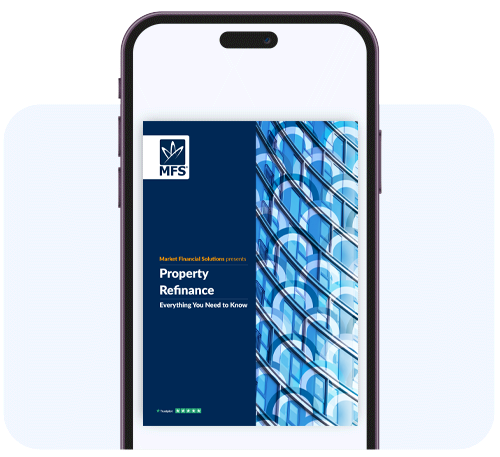Everything You Need to Know
- The complexities of refinancing explained simply
- Comprehensive coverage of refinancing types
- Examples of refinance in selected case studies
- Expert insights
- Actionable tools to gain clarity
Get your free Refinancing Guide below.

Refinancing a property simply explained
This guide will cover the crucial world of refinancing a property. We will tackle the basics, through to the intricacies of the process. Getting on top of it all is important.
Much of the lending industry is centred around refinancing, as opposed to issuing first-time loans. Chances are, that borrowers moving onto much higher rates than they’re used to. As such, they’ll want to find the best deal possible for their circumstances.
And circumstances are important. Refinancing for a commercial property will be very different than a residential deal. There are complications to consider, alongside various pros and cons, and this guide will go through it all.

Why work with Market Financial Solutions
Market Financial Solutions was created to support property investors with their plans through good times and bad. We embrace flexibility in our underwriting and lending practices, striving to find ways forward in the face of CCJs, bankruptcies, and adverse credit issues.
This commitment spreads across our product range, which includes our refinancing options. Our refinancing loans can be utilised for a broad range of property types and investment strategies. This includes residential, commercial, and mixed-used properties.
We can consider borrowers looking to refinance as an individual or through an SPV, an offshore company, even if the company ownership has changed.
What’s more, we can help our borrowers refinance internally, as well as consider external factors. For instance, a borrower utilising one of our bridging products for an acquisition could refinance onto our BTL mortgage product, should it suit their circumstances and end-goals.
Regardless of how our borrowers refinance, we will be able to find a way forward swiftly, and smoothly. Where everything lines up and is accounted for, we can have refinance capital issued in as little as three days.

What is refinancing a property?
Refinancing generally involves replacing one kind of loan with another. There are many reasons why a borrower would want to do that. But, what is refinancing a property, and how does the process typically work in the real estate sector?
Typically, when it comes to refinancing a property, mortgages are involved. A borrower will be replacing an existing mortgage with a new one. In the specialist market, refinancing a property may also involve moving on to (or off) a bridging loan, or a bespoke BTL mortgage. Outside of property, other forms of debt can also be refinanced. Examples include car loans, and perhaps student loans.
The initial concept of refinancing may be straightforward. But we still need to address the question of how to refinance a property. Generally, there are a few key steps all borrowers should take before they act. Initially, it’ll be prudent to assess one’s current mortgage or loan situation.
From here, they can then focus on determining if refinancing is right for their circumstances, trying to get their timing right, evaluating their financial position and goals, and preparing for the actual process[1].
To refinance a property, borrowers will need to approach their lenders. From here, the two parties will be able to discuss options, negotiate terms, and hopefully find a way forward. Obviously, this may be easier said than done, which is why borrowers can work with brokers and/or financial advisors to help with the logistics.
The actual process will require specific documentation from the borrower. This includes recent pay slips, bank statements, tax returns and more[2]. The lender involved will advise on what’s needed.
Also, borrowers need to be mindful of their LTV. An LTV ratio will directly impact the options available to a borrower, and the quality of the deals they’ll find. If a borrower has been paying off a loan consistently for a while, and the property involved has gone up in price, then their LTV will be lower than it was when they first took out the loan. As a result, better deals may be available[3].

Reasons to refinance
So why refinance at all, as opposed to sticking with one term or deal for the long-term? Well, as interest rates shift in the market, refinancing can allow borrowers to benefit from cheaper deals. Better terms can also become available, such as shortened loan lengths, and adjusted payment schedules which may better suit the borrower’s circumstances.
Refinancing may also simply help with a borrower’s admin. For example, they may want more predictability in their repayments, and refinancing can allow them to move from a variable rate, to a fixed-rate product. Refinancing can allow for debt consolidation, equity release, and even porting a mortgage.
It’s important to remember though, that the benefits of remortgaging will be dependent on the underlying borrower’s circumstances. Refinancing may allow one borrower to access lower rates, but another may not be so lucky. As with any financial decision, careful consideration should be given before any action is taken.
Types of refinances
There are many different types of refinances, depending on the borrower’s preferences and objectives. The type required for seeking out a better deal may look very different to a plan for an equity release remortgage.
There are a few key forms of refinancing, however, that are especially common in the property market. There is consolidation refinance, which allows borrowers to collate multiple debts into one simple obligation. A borrower here would need to keep on top of one monthly repayment, instead of multiple. By consolidating one’s debts, it can result in lower interest payments.
There is also cash-in, as well as cash-out refinancing. Cash-in refinancing involves refinancing debts while reducing the capital balance via a cash input from the borrower themselves to cover any shortfall. The idea is to cut the balance, and in turn reduce how much interest is paid.
Cash-out refinancing involves refinancing while taking out a bigger loan than what the borrower is already collectively repaying. The goal is to use the additional funds that are released to the borrower, to spend or invest as they see fit.
Rate-and-term refinancing offers an internally structured way forward for borrowers. Here, a change is made to the interest rate or term of an existing loan, without making a change to the actual loan balance. This is done to reduce the interest rate or to extend or reduce the time taken to repay the loan
Within the property investment market, borrowers are likely to seek alternative loans and mortgages with external providers to find better deals. Within Market Financial Solutions, it’s possible to refinance from a bridging loan to one of our BTL mortgages, and vice-versa.

How to increase your loan amount
Some may refinance to increase their loan amount. Often referred to additional borrowing, it involves borrowing more money and boosting the size of the mortgage. The extra funds can be used for a range of purposes, such as a refurbishment. To do this, borrowers will usually need to have a solid financial history, steady income streams, and plenty of equity built up in their asset.
Lenders will have differing criteria involved when it comes to increasing loan sizes via remortgaging. To help with this, borrowers can seek guidance from mortgage advisors and other financial experts.
Also, Market Financial Solutions has a free, interactive BTL calculator on its website which allows users to work out what options may be available to them. This may include utilising up to 130% Interest Coverage Ratio (ICR) on our loans, or our deferred/rolled interest options. From here, they can reach out to an underwriter to get exact figures for their plans.

Refinancing certain property types
Residential refinance
Residential refinance may be the easiest to wrap one’s head around. Typically, when a person is refinancing a residential asset (a house, flat, etc), they will be remortgaging. Here, the borrower will be swapping their current mortgage with a new one, and the new lender will pay off the existing term with the new mortgage.
Residential refinance can also involve taking out a new mortgage for the first time, which is then secured against the property. While the process itself will need to be started by the homeowner/borrower, the remainder will largely be handled by the legal teams involved.
Refinancing a commercial property
Refinancing a commercial property will likely follow a similar process to residential deals. Lenders will review the property value, LTV ratio, financial stability of the borrower, the property’s conditions, and other basics for both residential and commercial refinancing cases. The main difference between the two will likely be that a commercial refinance will only be applicable for non-residential real estate. Lenders will also likely factor in commercial concerns when assessing the deal, such as the strength of the underlying sector. One key calculation that commercial borrowers may come across is earnings before interest, tax, depreciation, and amortisation (EBITDA).
Portfolios
Many property investors and portfolio landlords may ask themselves “can you refinance a portfolio loan”. In short, yes, it is possible to refinance via a portfolio loan. Portfolio remortgages/loans allow borrowers to collate all their deals into a single form of finance. This may simplify their admin, and offer better terms.
Other refinancing types
While property investors are likely to solely deal with residential, commercial, or portfolio refinancing, they may come across other kinds. For example, asset refinance exists, which allows business owners to free up capital. This is a type of refinance that is raised against niche forms of security, such as machinery, equipment, and vehicles. As to be expected, the best form of refinance for any borrower will be dependent on their circumstances.
Refinancing from overseas
Those investing from overseas, either as a foreign national or UK expatriate, will also be able to refinance. In fact, many lenders will have refinancing products specifically designed for foreign nationals. With these products, lenders will typically look at the borrower’s UK credit history or footprint, their financial circumstances, and where they live.
Refinancing from abroad can be complicated, however. As such, it may prove useful to utilise guidance from specialist brokers or other experts.
Lenders will have different preferences for overseas borrowers. Many will require the borrower to have a UK bank account, while others will want the borrower to receive their income in GBP[4].
Also, with overseas refinancing deals, LTVs may be capped at between 60%-80%. With foreign nationals, lenders may focus on the borrower’s visa situation, how much time they spend in the UK, and where the money for the repayments will come from[5].
At Market Financial Solutions, we can consider applicants from any country, other than those that are sanctioned.

Challenges & impact of refinancing a property
While refinancing a property can allow borrowers to secure cheaper deals and better terms, there are some potential challenges involved that all borrowers should be aware of.
With residential remortgages, for example, there could be closing costs of between 2% and 6% of the new loan amount[6]. Also, if the new loan has a longer repayment period, it could add more longer-term costs with the added interest. Similar downsides may emerge with commercial refinancing. There may also be heightened risk of paying early repayment charges, and facing new tough restrictions or terms.
Moreover, the options available to borrowers may be limited by market conditions. Perhaps when an original loan was taken out, the property market was in a healthy state and interest rates were low. But, when the time comes to refinance, the market is in a downturn and rates have shot up.
Also, as is the case with many lending transactions, a refinance loan may result in a hard inquiry on one’s credit report[7]. This can negatively impact a borrower’s record, albeit temporarily. While a single credit check is unlikely to cause long-term problems, multiple checks in quick succession can raise red flags. Those who are shopping around for the best deal possible may be at risk here.
To mitigate the potential risks of refinancing, property investors should ensure that they’re in the best place to move forward. Also, utilising the help of mortgage brokers and other advisors can help ensure that they get the best deal possible for their circumstances.

The process & how long it takes
Property investors or homeowners coming to the end of their current term are likely to start concerning themselves with when to refinance a mortgage, and wondering how long does it take to refinance a mortgage? After all, it is unwise to leave it to the last minute to try and get one’s financial affairs in order.
While the exact process is likely to differ from one lender to another, most borrowers will need to get the ball rolling by securing a mortgage or loan deal from a lender. They will need to make the first move here and so it’s important they check that they match the lender’s eligibility criteria. Brokers and the like can help with this.
From here, the legal teams involved will step in to make sure all the documents needed are accounted for. This will include land registry documentation, title checks, and more. When everything is accrued and the lenders conditions are satisfied, all the parties involved can look towards completion dates.
Timing is important here. Generally, it may take between four and eight weeks to remortgage in the residential market[8]. But, the sooner one starts planning for their refinancing strategy the better. Most lenders will allow borrowers to lock in a new rate if their fixed deal is coming to an end within the coming six months[9].
By being organised, borrowers can avoid rolling on to costly default rates at the end of their term. Also, if they’re refinancing with an external lender, they may be able to get ahead of any forecasted negative downturns.
Costs & fees
While refinancing can deliver better results and more favourable terms over the long-term, there are certain immediate costs that need to be factored in. To start with, borrowers are likely to face an early repayment charge with their existing lender, which could be as high as 5%[10].
Then, with securing a new deal, there could be arrangement fees, booking fees, valuation fees, conveyancing fees, broker fees and more. While not all lenders will charge all these fees, and rates between them will vary, refinancing fees could still equate to thousands of pounds.
Also, while many borrowers likely refinance to try and find a better deal, many may actually pay more interest when they refinance in the current market. Interest rates have shot up in recent years, which is set to catch many off guard.
Some 31% of all mortgages, or 2.7 million people, are expected to refinance onto a rate of over 3% for the first time by the end of 2027, according to the Bank of England[11]. Once again, it’s important to remember that borrowers should assess carefully if refinancing is right for their circumstances.

Case study 1
Refinancing can be a complicated endeavour, especially in the specialist lending market. Borrowers in need of bespoke solutions often have unique challenges of their own, such as adverse credit issues, or complicated financial set ups.
Fortunately, at Market Financial Solutions, we’re capable of handling whatever complexities the market throws at us. Take for example, this case, where we had to deliver refinancing capital not only to cover an existing facility, but also other outstanding debts.
These outstanding debts needed to be addressed before the borrower could move forward with their investment. They planned to move onto long-term finance for the exit strategy, but this would be difficult unless their obligations were cleared. As such, we put plans in place to ensure their main external bill would be covered, which allowed us to progress.

Case study 2
An investment plan itself can also pose challenges. This borrower turned to us for refinance to provide time to tidy up their conversion plans, and move onto development exit finance for the exit strategy. They planned to convert a commercial property into a residential space.
But, the condition of the property was poor, given that the investor was in the very early stages of works. To ensure the condition of the property didn’t hold back the investment, we ensured that the borrower had multiple exit strategies available to them, should their original plan not work out. We also added additional contingency plans in place to accommodate the state of the underlying property. With everything accounted for, we were able to deliver funding.

Case study 3
Our refinancing deals also factor in potential future developments. This client was a seasoned BTL investor, who had sensible plans to clear an existing facility with our funding. We were confident they’d be able to cover the repayments in the interim but, the planned exit strategy posed challenges.
The borrower planned to sell the asset at the end of the term. This made it hard to factor in sales statistics, as any current data wouldn’t be relevant to the market at the term’s end. To mitigate this, our underwriter included a condition to have the property put on the market within certain timeframes – diminishing the risk involved.
With contingency plans in place, coupled with the security’s solid desirability, we were able to provide funding quickly.

Conclusion
Refinancing, for both residential and commercial property investors alike, is a crucial element of an investment strategy. Time it right, and borrowers can secure better terms, consolidate their obligations, and even lower their costs.
But, there is also the risk of facing high fees in the process, and ending up on much higher rates if one isn’t prepared. We understand how important it is for borrowers to get their refinancing plans organised swiftly, and efficiently.
This is why our refinancing loans are delivered with as much care and diligence as our purchasing loans are. Refinance can be issued within mere days and every single deal is underwritten from day one.
Where property investors fret over their way forward in a tough economic climate, we will be there to provide clarity, and a way forward.
[1] https://www.equifax.co.uk/resources/mortgage/refinancing-your-mortgage
[2] https://www.experian.com/blogs/ask-experian/how-does-refinancing-a-mortgage-work/#s2
[3] https://www.unbiased.co.uk/discover/mortgages-property/ownership-improvements/loan-to-value-ratio-and-your-mortgage#how-does-my-ltv-ratio-affect-remortgaging
[4] https://www.onlinemortgageadvisor.co.uk/uk-expat-mortgages/expat-remortgage/
[5] https://www.onlinemortgageadvisor.co.uk/mortgage-application/foreign-national-mortgage/#what-are-the-guidelines
[6] https://www.experian.com/blogs/ask-experian/pros-and-cons-refinancing-you-home/#s2
[7] https://www.experian.com/blogs/ask-experian/how-does-refinancing-a-mortgage-work/#s4
[8] https://www.halifax.co.uk/mortgages/help-and-advice/how-long-does-it-take-to-remortgage.html
[9] https://www.thetimes.com/money-mentor/mortgage-property/remortgaging/should-i-fix-my-mortgage-now
[10] https://www.moneysavingexpert.com/mortgages/remortgage-fees/
[11] https://www.morningstar.co.uk/uk/news/257886/4-million-households-face-mortgage-cost-increase-by-2027-boe-says.aspx
Disclaimer
Market Financial Solutions are a bridging loan and buy-to-let mortgage provider, not financial advisors. Therefore, Investors are encouraged to seek professional advice. The information in this content is correct at time of writing.
